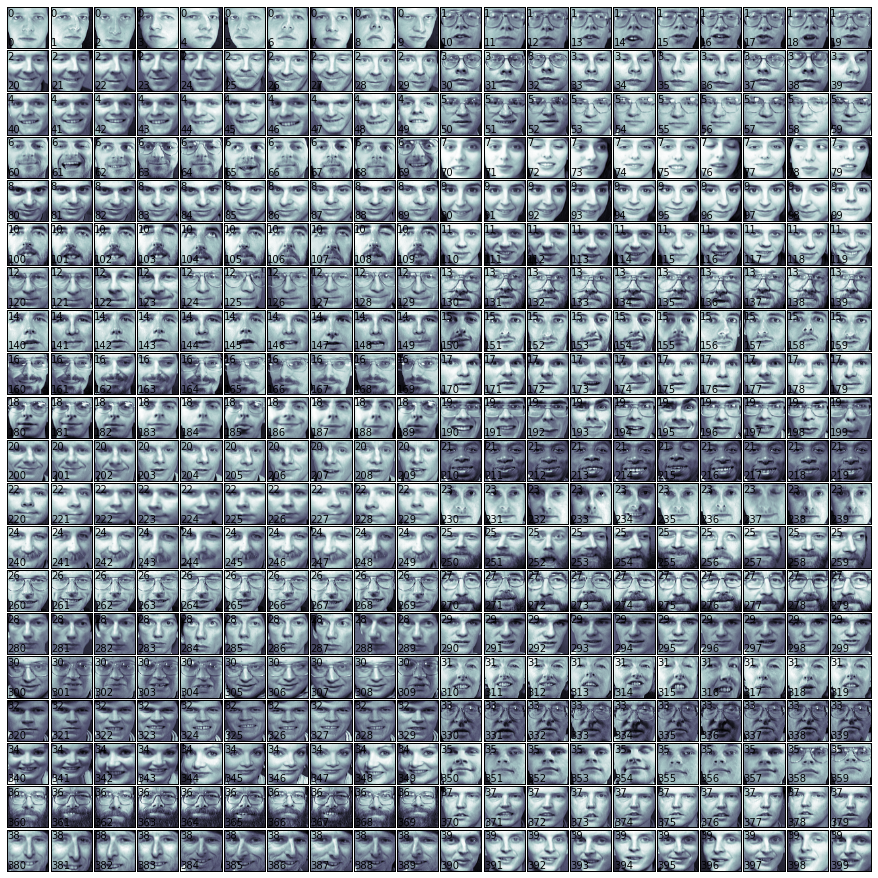Modified Olivetti faces dataset.The original database was available from (now defunct)
http://www.uk.research.att.com/facedatabase.html
The version retrieved here comes in MATLAB format from the personal
web page of Sam Roweis:
http://www.cs.nyu.edu/~roweis/
There are ten different images of each of 40 distinct subjects. For some
subjects, the images were taken at different times, varying the lighting,
facial expressions (open / closed eyes, smiling / not smiling) and facial
details (glasses / no glasses). All the images were taken against a dark
homogeneous background with the subjects in an upright, frontal position (with
tolerance for some side movement).
The original dataset consisted of 92 x 112, while the Roweis version
consists of 64×64 images.
Veamos el dataset. faces.images tiene 400 imágenes de rostros, cada una está compuesta por una matriz de pixeles de 64×64. faces.data tiene la misma cantidad de datos pero en filas de 4096 atributos en lugar de una matriz (4096 = 64×64).
print(faces.keys())
print(faces.images.shape)
print(faces.data.shape)
print(faces.target.shape)
dict_keys([‘DESCR’, ‘target’, ‘data’, ‘images’])
(400, 64, 64)
(400, 4096)
(400,)
No tenemos que escalar los atributos, porque ya se encuentran normalizados.
print(np.max(faces.data))
print(np.min(faces.data))
print(np.mean(faces.data))
1.0
0.0
0.547046
def print_faces(images, target, top_n):
# configuramos el tamaño de las imágenes por pulgadas
fig = plt.figure(figsize=(12, 12))
fig.subplots_adjust(left=0, right=1, bottom=0, top=1, hspace=0.05, wspace=0.05)
for i in range(top_n):
# graficamos las imagenes en una matriz de 20x20
p = fig.add_subplot(20, 20, i + 1, xticks=[], yticks=[])
p.imshow(images[i], cmap=plt.cm.bone)
# etiquetamos las imágenes con el valor objetivo (target value)
p.text(0, 14, str(target[i]))
p.text(0, 60, str(i))
print_faces(faces.images, faces.target, 20)

Graficamos todos los rostros en una matriz 20×20, para cada uno, ponemos el valor objetivo (target value), en la esquina superior izquierda y el índice en la esquina inferior izquierda.
print_faces(faces.images, faces.target, 400)

Vamos a construir un clasificador o Classifier cuyo modelos es un hiperplano que separa instancias (puntos) de una clase del resto. Los métodos Support Vector Machines intentan obtener estos hiperplanos de una manera óptima, mediante la selección de las caracteristicas que tengan las mayores diferencias posibles con instancias de diferentes clases. Las nuevas instancias serán clasificadas como pertenecientes a una determinada categoría en función de que lado del hiperplano entran. Vamos a importar la clase SVC desde el módulo sklearn.svm SCV (Support Vector Classifier).
from sklearn.svm import SVC
svc_1 = SVC(kernel='linear')
print(svc_1)
SVC(C=1.0, cache_size=200, class_weight=None, coef0=0.0,decision_function_shape=None, degree=3, gamma=’auto’, kernel=’linear’,max_iter=-1, probability=False, random_state=None, shrinking=True,tol=0.001, verbose=False)
Creamos los conjuntos train y test
from sklearn.cross_validation import train_test_split
X_train, X_test, y_train, y_test = train_test_split(
faces.data, faces.target, test_size=0.25, random_state=0)
Establecemos 5-fold cross-validation
from sklearn.cross_validation import cross_val_score, KFold
from scipy.stats import sem
def evaluate_cross_validation(clf, X, y, K):
# creamos un k-fold croos validation iterator
cv = KFold(len(y), K, shuffle=True, random_state=0)
# por defecto el puntaje usado es el devuelto por el estimator (exactitud)
scores = cross_val_score(clf, X, y, cv=cv)
print(scores)
print(("Mean score: {0:.3f} (+/-{1:.3f})").format(
np.mean(scores), sem(scores)))
evaluate_cross_validation(svc_1, X_train, y_train, 5)
[ 0.93333333 0.86666667 0.91666667 0.93333333 0.91666667]
Mean score: 0.913 (+/-0.012)
from sklearn import metrics
def train_and_evaluate(clf, X_train, X_test, y_train, y_test):
clf.fit(X_train, y_train)
print("Exactitud training set:")
print(clf.score(X_train, y_train))
print("Exactitud testing set:")
print(clf.score(X_test, y_test))
y_pred = clf.predict(X_test)
print("Reporte de Classificador:")
print(metrics.classification_report(y_test, y_pred))
print("Confusion Matrix:")
print(metrics.confusion_matrix(y_test, y_pred))
Medimos precision y recall en el set de evaluación en cada clase
train_and_evaluate(svc_1, X_train, X_test, y_train, y_test)
Exactitud training set:
1.0
Exactitud testing set:
0.99
Reporte de Classificador:
precision recall f1-score support
0 0.86 1.00 0.92 6
1 1.00 1.00 1.00 4
2 1.00 1.00 1.00 2
3 1.00 1.00 1.00 1
4 1.00 1.00 1.00 1
5 1.00 1.00 1.00 5
6 1.00 1.00 1.00 4
7 1.00 0.67 0.80 3
9 1.00 1.00 1.00 1
10 1.00 1.00 1.00 4
11 1.00 1.00 1.00 1
12 1.00 1.00 1.00 2
13 1.00 1.00 1.00 3
14 1.00 1.00 1.00 5
15 1.00 1.00 1.00 3
17 1.00 1.00 1.00 6
19 1.00 1.00 1.00 4
20 1.00 1.00 1.00 1
21 1.00 1.00 1.00 1
22 1.00 1.00 1.00 2
23 1.00 1.00 1.00 1
24 1.00 1.00 1.00 2
25 1.00 1.00 1.00 2
26 1.00 1.00 1.00 4
27 1.00 1.00 1.00 1
28 1.00 1.00 1.00 2
29 1.00 1.00 1.00 3
30 1.00 1.00 1.00 4
31 1.00 1.00 1.00 3
32 1.00 1.00 1.00 3
33 1.00 1.00 1.00 2
34 1.00 1.00 1.00 3
35 1.00 1.00 1.00 1
36 1.00 1.00 1.00 3
37 1.00 1.00 1.00 3
38 1.00 1.00 1.00 1
39 1.00 1.00 1.00 3
avg / total 0.99 0.99 0.99 100
Confusion Matrix:
[[6 0 0 …, 0 0 0]
[0 4 0 …, 0 0 0]
[0 0 2 …, 0 0 0]
…,
[0 0 0 …, 3 0 0]
[0 0 0 …, 0 1 0]
[0 0 0 …, 0 0 3]]
Discriminar personas con lentes o sin lentes (gafas)
El desempeño en el reconocimiento de rostro es bueno. Pero, hay un problema. Vamos a clasificar las imágenes de personas con y sin gafas
#indices de imagenes de personas con lentes
glasses = [(10, 19), (30, 32), (37, 38), (50, 59), (63, 64),
(69, 69), (120, 121), (124, 129), (130, 139), (160, 161),
(164, 169), (180, 182), (185, 185), (189, 189), (190, 192),
(194, 194), (196, 199), (260, 269), (270, 279), (300, 309),
(330, 339), (358, 359), (360, 369)]
Creamos un nuevo conjunto de training y test
def create_target(segments):
#creamos un nuevo array "y"
y = np.zeros(faces.target.shape[0])
# put 1 in the specified segments
for (start, end) in segments:
y[start:end + 1] = 1
return y
target_glasses = create_target(glasses)
X_train, X_test, y_train, y_test = train_test_split(
faces.data, target_glasses, test_size=0.25, random_state=0)
[ 1. 0.95 0.98333333 0.98333333 0.93333333]
Mean score: 0.970 (+/-0.012)
Exactitud training set:
1.0
Exactitud testing set:
0.99
Reporte de Classificador:
precision recall f1-score support






Comentarios recientes